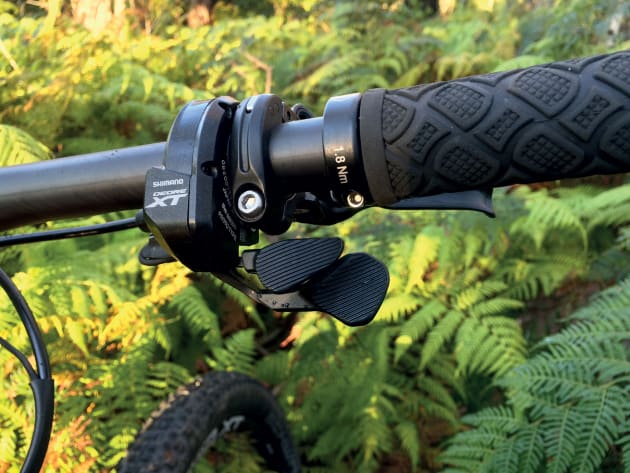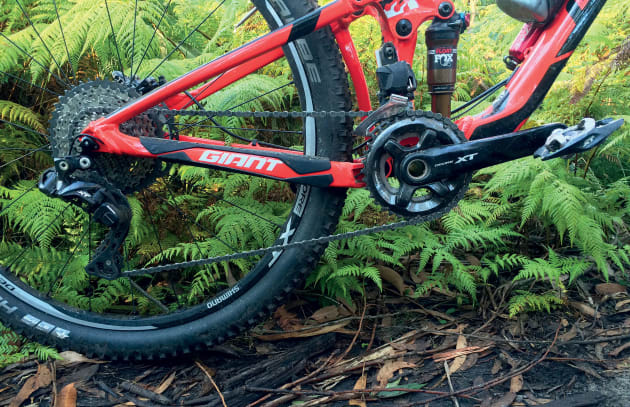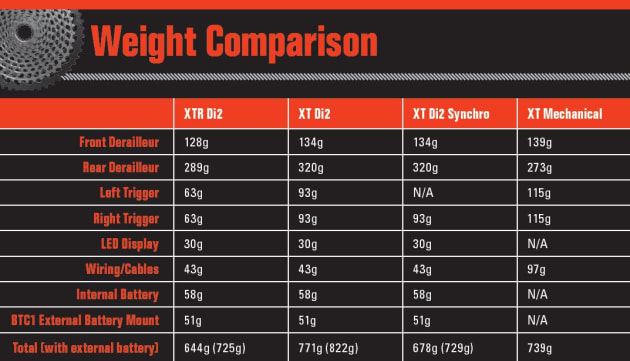Shimano XT Di2
Having ridden XTR Di2 in its prototype stages – when it was nothing more than an agricultural assembly of CNC machined alloy blocks – we’re not exactly new to electronic shifting. We have ridden a number of times in production form too, but this is the first time we’ve had the opportunity to spend a good amount of quality time on the Di2 system.
Shimano’s Di2 electronic gear shifting was released on their top-flight Dura-Ace road groupset in 2009 and it has now trickled down to Ultegra level (it’s expected to hit the mid-range 105 group later this year too). So when the same system was launched on their XTR mountain bike group in 2014, we knew it was only a matter of time before we saw a more affordable version. That time has come and XT Di2 will run alongside the mechanical option, appearing as standard spec on many 2017 model bikes.
The big question for many will be ‘how affordable?’ XTR has always been Shimano’s no-holds-barred flagship group; the one that’s loaded with all the titanium and carbon fibre bits, so there’s no hiding the fact that the electronic version costs a bomb. If a stick destroys your XTR Di2 rear derailleur, you’ll be around $900 poorer! Do the same with the new XT Di2 and you’ll be $500 out of pocket. So, while XT Di2 is not in any way cheap, it costs a whole lot less than its flashy big brother.
To put it another way; if you’re looking to buy the shifting components on their own (derailleurs, shifters and battery), XT Di2 will set you back a little more than the equivalent XTR mechanical parts. Over the entire groupset (complete drivetrain, cranks and brakes), XT Di2 will cost less than an XTR mechanical groupset. That should give you an idea of how it’ll fit into the scheme of things and we’ve already seen XT Di2 spec’d on carbon hardtails for $5,500.
Less Cash but Still Flash
While the pricing is a little more realistic, the Di2 components don’t look cheaped-out in any way. The lines and dimensions mirror the XTR parts, it just has a more subtle all-black finish rather than the smoky chrome look—if anything we prefer the more subdued aesthetics.
When compared to the mechanical version, the derailleurs are a tad chunkier but overall the drivetrain doesn’t look too different. If anything the shifters are less bulky and our demo bike had the battery hidden inside the seatpost, so the bike as a whole was super tidy. You don’t need a dedicated Di2 bike to run the battery internally; in many cases it can be slipped into the seat tube or inside the fork steerer. Charging is done via the bar mounted control unit, so the battery itself doesn’t need to be accessible. If you’re using a 2X setup, you can also run it in ‘Synchro mode’ and eliminate the left-side trigger for an even tidier handlebar setup—more later on the Synchro function.

Electric Advantage
So what’s the point of electronic shifting; what can it offer that good old Bowden cables can’t? Many assume that electric parts won’t survive for long in the grubby world of mountain biking. While it’s true that electronics, dirt and moisture don’t generally mix well, XTR Di2 has been out for a few years with no reliability issues. Dura-Ace Di2 is getting on for eight years old and it has also been bombproof.
XT Di2 is based on the same design and there’s no reason why it won’t offer a similar level of reliability. In the time that we’ve had our demo bike, the trails have been quite wet. We’ve taken advantage of this, throwing the bike through plenty of mud as well as completely submerging the bike twice on botched creek crossings—all in the line of duty of course!
Despite the inclement conditions, we didn’t encounter any glitches; in fact it survived better than a mechanical system would. The most common causes of shifting problems are cable stretch and excessive friction. In really sloppy conditions, traditional cables can foul up within a 90 minute XC race. Running full-length outer casing will give you a better chance but the shift quality will still deteriorate over time.
The XT Di2 didn’t waver, even in the worst conditions; it’s basically a set-and-forget system. Each press of the shift-button moves the derailleur the same pre-set distance no matter what—it’s unaffected by mud, water and foul weather. We even attacked it with a high-pressure gerni with no ill effects; if it can survive that torture test, a little bit of rain won’t hurt it.
Of course the drivetrain itself remains vulnerable and somewhat fragile, just like any derailleur equipped bike. While the electrics soldier on unaffected by mud, the chain and cassette will still suffer accelerated wear. The shifting will also be compromised if you bend the derailleur hanger in a crash, and a good-sized stick can still destroy the rear mech—you’ll just be looking at $500 for a replacement instead of $170! We won’t be rid of these issues until someone introduces a light, efficient and affordable wide-range gearbox system.
While we’re on the topic of worst case scenarios, we should mention a couple fail-safes that Shimano has built into the system. If you hit the rear derailleur hard enough, the electronic motor will disengage to reduce the chance of permanent damage. If this happens, you need to first check the derailleur hanger is straight, and then hit ‘crash recovery mode’ to return things to normal. If the shifting does go out of adjustment – probably due to a bent hanger as it can’t be cable adjustment – the shifting can be tweaked manually on the trail. And finally, while the derailleurs may be expensive, they are also more repairable than their mechanical counterparts. The front derailleur cage can be replaced as a separate item for example and the same applies on the rear.
Power Shift
Aside from its consistency in poor conditions, there is also an improvement in the general shift quality. Each press of the trigger produces a nice tactile ‘click’ that makes it absolutely clear that you’ve instigated a shift. From there the gear change is executed with clinical precision. Good mechanical shifting is pretty hard to fault, but it is still possible to stuff up when you’re tired or if you just push the gear lever in a haphazard or indecisive manner. With Di2 there are no mistakes; you either click the trigger or you don’t and it completely removes human error from the equation.
This is especially apparent when it comes to shifting between chainrings on a 2X system. Shimano is renowned for their industry-leading front shifting (SRAM has more or less binned the idea with their push towards 1X) but Di2 takes this to the next level. Even the best mechanical systems require a long lever throw and some force to instigate a shift. With Di2 you just push a button and the powerful motor in the front derailleur does the rest. Not only is it effortless, it’s also very decisive. It will shift the chain from the small up to the big chainring under full load whilst pedalling uphill, and it does this smoothly and reliably (check this Instagram link for an example). Need to dump a bunch of gears in a hurry? Just hold a shift button down and it’ll quickly move the chain all the way across the cassette.
There’s also an element of built-in intelligence that you don’t get with the mechanical equivalent, especially if you’re looking at a multi-chainring drivetrain. As you shift across the cassette, the front derailleur moves across automatically to eliminate chain rub. It also prevents you from shifting into poor gear combinations. For example, you can’t access the three smallest cogs when using the small chainring; these are locked out, as it knows there’s not enough chain tension in these gears.

Get Synchronised
The real highlight of the Di2 MTB drivetrain is the Synchro shifting. This coordinates both derailleurs, allowing you to use one gear shifter. Take full advantage of the Synchro option and you can remove the left hand trigger completely; this cleans up the handlebars and saves 93g, making the Di2 drivetrain lighter than the mechanical version. Alternately, you can retain the left trigger and use it to control the suspension lockout (assuming you’re running Fox iCD shocks).
Synchro is not an automatic like you’ll find in a car; you still shift manually via the right hand trigger. Say you’re in the big ring on a 2X system and you shift into the 40 tooth cog on the cassette; at this point the system beeps twice warning that the next shift will drop you to the small chainring.
Click the right hand trigger again and the next downshift drops you into the smaller chainring whilst simultaneously upshifting one cog on the back. Sounds like a complicated manoeuvre but as mentioned earlier, the chainring shifts are super smooth. Rather than jumping to a much easier gear, the simultaneous front and rear shift puts you in a gear ratio that’s only slightly lower than before, so it won’t break your pedalling rhythm.
A similar process occurs as you shift up through the gears. Click away as you accelerate and you’ll get another double beep part way down the cassette. With the next upshift the front derailleur leaps into action and you get that little extra compensatory shift on the rear to maintain a steady change in gear ratios.
It may sound complex but for the rider it’s simple-as; one button shifts to an easier gear, the other button takes you to a harder one—the Di2 system does the rest. I was pretty happy with how the Synchro system worked and ran the bike with a single shifter for the majority of the review.

Program & Personalise
As with XTR Di2, you can customise the Synchro shift maps, change the function of the triggers, alter the shift speed and more. Previously this was done by plugging your bike into a PC but XT Di2 comes with Shimano’s new E-Tube system. Using a smartphone or tablet, you can connect to the bike via Bluetooth and customise away. In addition to being more accessible, the app makes the whole process more user friendly.
With the stock setup, the more forward placed trigger on the right hand side sent you into an easier gear. This didn’t feel right to me so I swapped it around—a simple task once the E-Tube app is installed on your phone. You can even tinker with it whilst you’re out on the trail, although you’ll probably leave it alone once you sort out the basic settings.
The only feature lacking on XT Di2 compared to the XTR version is the ability to double shift by pushing the trigger a bit further in. XT triggers only offer a single click but the ability to sweep across a number of gears by holding the button down means this feature was never missed—well not by me anyway.

Battery Life
Aside from a fear that it’ll implode in the wet, the most common fear is that the battery will go flat partway through a ride. The battery may be small – only 58g and 500mAh – but it allowed us to ride for over 18 hours before we considered a recharge, and that was with more gear shifting than we’d normally do (we were testing it after all).
Under normal singletrack riding conditions on a 2X system, you should be able to get well over 20 hours from a freshly charged battery. Jessica Douglas ran a Di2 at her last Stromlo 24 hour and finished with two out of the five bars still remaining on the handlebar mounted display. It’s safe to say that battery life will be a non-issue for 99% of mountain bikers.
Need for Power
With all of these advantages, you’re probably expecting me to preach of how electronic shifting is a total game changer. Well I’m not.
When I returned the Di2 rig and hopped back on my own bike, I didn’t miss the electronics at all. Modern mechanical shifting works extremely well; it’s consistent, offers a nice light feel at the lever and changes through the rear cassette under heavy pedalling loads. Sure, the Di2 shifting is even lighter and more precise but it’s not the sort of difference that’s going to have me rushing out to convert.
Di2 really starts to shine where traditional systems falter—in wet muddy conditions that bung up your cables or when you are fatigued and prone to mistakes. It also offers real advantages if you’re a 2X user; the Synchro system works a treat, so one trigger is all you need. I prefer to run a single ring with a chain guide, but that’s my choice; it suits my trails and riding style.
If I was racing marathon events in hilly terrain, I’d be all over a double ring Di2 drivetrain. With two chainrings providing a broad total gear spread, you can run a cassette that offers closer gear steps. In an XC race or marathon setting, this can save energy as there’s always a gear to match your speed and you won’t run out of top-end on the faster pedalling sections. Of course Di2 remains a legit option for 1X setups too, it’s just the advantages aren’t as obvious there.
So as with anything it’s a matter of horses for courses. For some Di2 will offer real benefits while others could take it or leave it. One thing is for sure, Di2 is a refined and reliable system that’s totally compatible with MTB use. It’s great to see Shimano offering electronic shifting at XT level, as it’ll put it within reach of a broader audience.
Shimano Australia
(02) 9526 7799
www.shimano.com.au









